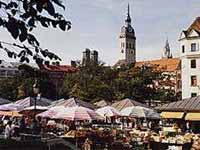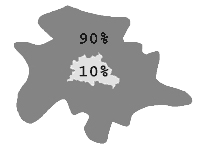| 1. An Understanding of the City
The present physical structure of cities is a product of socio-political systems with diverse ideologies regarding the city. Their conception of urban planning and design, location of services and facilities of all kinds as well as the principles of segregation of society differ greatly from one another. [Lichtenberger 1991] Today, the city is the human settlement form with the highest population. In Germany, the image of the compact European city with a historical core strongly influences the population's perception as well as the political and cultural discussion. The reality of the city is something else entirely however, and has been so for some time: even in Germany the historical city core makes up only a fraction of the city's area. About 90% of a city's populated area lies outside of the core. [Sieverts 1999] The positive connotation of the historical city is countered by the perception of the periphery. Massive uses of open space, sprawl, disjunction, etc. are the negative terms associated with a loss of clearly defined urban structures. The hierarchical relationship and dependency between core city and surrounding area have changed drastically: the peripheral structures carry out distinctively urban functions and are no longer purely residential areas. They would leave a core without basis for existance behind, were they to disappear. This dynamically spreading global phenomenon has up to date not been termed consistantly worldwide. In Germany it is usually condensed to the term "dispersed settlement" (Zersiedlung), the USA commonly use the term "urban sprawl". This paper descripes the current discussion of peripheral growth in the U.S. and in Germany. The goal of this paper is to show the potential inherent in new methods of information and visualization to make the population aware of "urban sprawl". The internet pages mentioned as resources were current in March of 2000.
|
||||||||
 |
||||||||
| the image of the European city | ||||||||
 |
||||||||
| the reality of the European city | ||||||||